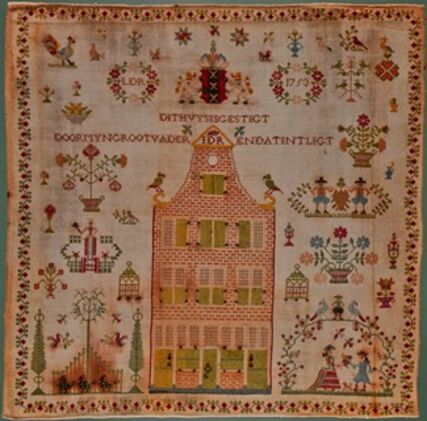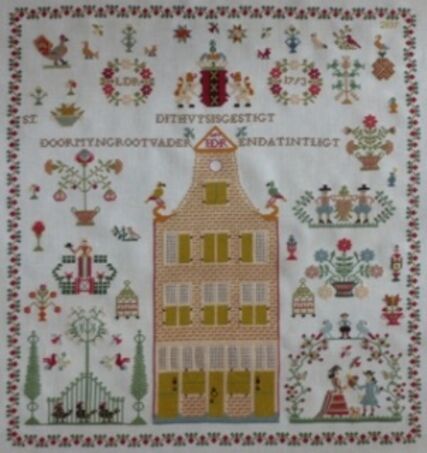LDR 1753
A Gabled House in Amsterdam


"This house was built by my grandfather IDR 1697" and roughly translated: "I show it for all the world to see."
In 1753, this statement was stitched by Laurentia de Ronbaij with silk floss in her splendid sampler – in memory of her grandfather and proud of the family property – a real building, a lifelike gabled house. A rare motif on Dutch merklappen!
Thanks to the information from the Rijksmuseum Amsterdam, we know more about this family. Jacob de Ronbaij (* 1655, † 1749) was blue dyer / blue printer and built the house in the Egelantiersgracht 14 in Amsterdam from 1693 to 1697. His son Willem (* 1699, † 1758) was stocking dyer and married Jacomina Selijns (* 1702, † 1783). They had three children: Lammertje (* 1738, † 1741), Laurentia (* 1740, † 1819) and Lammertje (* 1743, † 1819). Until her death, Laurentia lived in this house, which adapted itself to the respective conditions and fashions over the decades. Gables, doors and windows changed.
Since the 17th century, Amsterdam became a boomtown. The number of inhabitants exploded, swampland was drained and the foundations of the houses were built on millions of wooden piles. Wealthy citizens were able to afford luxurious gabled houses along a subtle system of major and minor waterways, the canals. Most houses were between four and six meters wide, but sometimes 25 meters long, because taxes were levied on the width and number of windows. Very few owners were able to afford the absolute luxury of a garden behind the house.
This urban ensemble from the 16th to 18th century of nearly 7,000 trading houses and warehouses as well as nearly 1300 bridges is evidence of the so-called Golden Age along the 165 canals and was declared a UNESCO World Heritage Site in 2010.
I was not only excited by the real gabled house as determining motif in this sampler, but also by the two garden scenes, namely the three chicken at the fence next to stately cypresses and the couple dressed in the fashion of the time under a rose arch: she with a tight bodice and a skirt, a so-called Cul de Paris, and he in breeches and cloak-and-sword, handing over a bunch of flowers.
Laurentia placed the coat of arms of Amsterdam above the house, the "Dutch Maid" (symbol of freedom and the victory over the Spanish rule in the 17th century) on the left and the motif of Caleb and Joshua (symbol of faith in God) on the right.
Plenty of little birds "flutter" all over the sampler and fill gaps. Are they symbolizing as winged beings the connection with God? She decorated her sampler with magnificent vases and everyday objects.
The original sampler (registration number: BK-KOG 1264) is owned by the Rijksmuseum Amsterdam. It suffered some light and moisture damage in the course of more than 250 years, which is why the original colors were difficult to identify. I have made an effort. A thank-you goes to the museum for sending the photos! I am very grateful to Rosa Pasquau for sending the hand-drawn pattern of "Eva Rosenstand" from 1983 and her embroidery. Finally, I thank Elisabeth Plante as well, who helped me on Facebook to understand the Old Dutch text.


